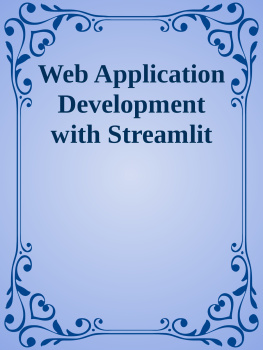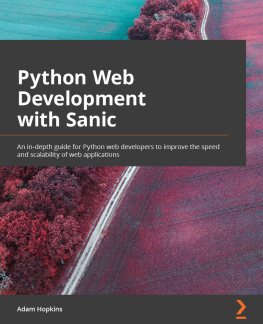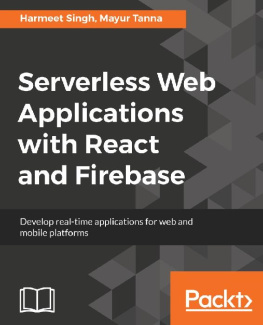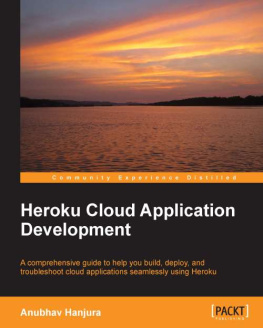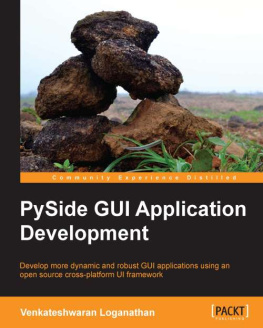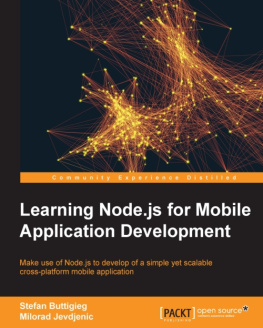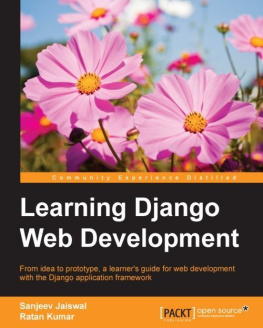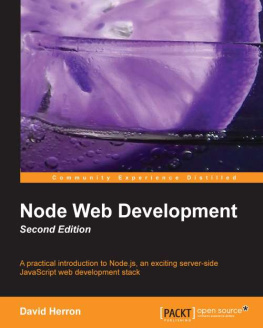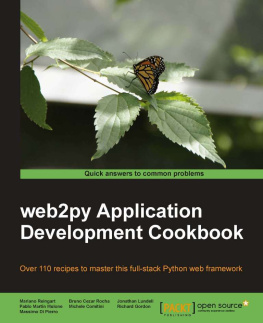Mohammad Khorasani - Web Application Development with Streamlit: Develop and Deploy Secure and Scalable Web Applications to the Cloud Using a Pure Python Framework
Here you can read online Mohammad Khorasani - Web Application Development with Streamlit: Develop and Deploy Secure and Scalable Web Applications to the Cloud Using a Pure Python Framework full text of the book (entire story) in english for free. Download pdf and epub, get meaning, cover and reviews about this ebook. year: 2022, publisher: Apress, genre: Computer. Description of the work, (preface) as well as reviews are available. Best literature library LitArk.com created for fans of good reading and offers a wide selection of genres:
Romance novel
Science fiction
Adventure
Detective
Science
History
Home and family
Prose
Art
Politics
Computer
Non-fiction
Religion
Business
Children
Humor
Choose a favorite category and find really read worthwhile books. Enjoy immersion in the world of imagination, feel the emotions of the characters or learn something new for yourself, make an fascinating discovery.
- Book:Web Application Development with Streamlit: Develop and Deploy Secure and Scalable Web Applications to the Cloud Using a Pure Python Framework
- Author:
- Publisher:Apress
- Genre:
- Year:2022
- Rating:4 / 5
- Favourites:Add to favourites
- Your mark:
- 80
- 1
- 2
- 3
- 4
- 5
Web Application Development with Streamlit: Develop and Deploy Secure and Scalable Web Applications to the Cloud Using a Pure Python Framework: summary, description and annotation
We offer to read an annotation, description, summary or preface (depends on what the author of the book "Web Application Development with Streamlit: Develop and Deploy Secure and Scalable Web Applications to the Cloud Using a Pure Python Framework" wrote himself). If you haven't found the necessary information about the book — write in the comments, we will try to find it.
Transition from a back-end developer to a full-stack developer with knowledge of all the dimensions of web application development, namely, front-end, back-end and server-side software. This book provides a comprehensive overview of Streamlit, allowing developers and programmers of all backgrounds to get up to speed in as little time as possible.
Streamlit is a pure Python web framework that will bridge the skills gap and shorten development time from weeks to hours. This book walks you through the complete cycle of web application development, from an introductory to advanced level with accompanying source code and resources. You will be exposed to developing basic, intermediate, and sophisticated user interfaces and subsequently you will be acquainted with data visualization, database systems, application security, and cloud deployment in Streamlit.
In a market with a surplus demand for full stack developers, this skill set could not possibly come at a better time. In one sentence, Streamlit is a means for the empowerment of developers everywhere and all stand to gain from it.
What Youll Learn
- Mutate big data in real-time
- Visualize big data interactively
- Implement web application security and privacy protocols
- Deploy Streamlit web applications to the cloud using Streamlit, Linux and Windows servers
Who is this Book for?
Developers with solid programming experience wanting to learn Streamlit; Back-end developers looking to upskill and transition to become a full-stack developers; Those who wish to learn and become more acquainted with data visualization, database systems, security and cloud deployment with SteamlitMohammad Khorasani: author's other books
Who wrote Web Application Development with Streamlit: Develop and Deploy Secure and Scalable Web Applications to the Cloud Using a Pure Python Framework? Find out the surname, the name of the author of the book and a list of all author's works by series.
Web Application Development with Streamlit: Develop and Deploy Secure and Scalable Web Applications to the Cloud Using a Pure Python Framework — read online for free the complete book (whole text) full work
Below is the text of the book, divided by pages. System saving the place of the last page read, allows you to conveniently read the book "Web Application Development with Streamlit: Develop and Deploy Secure and Scalable Web Applications to the Cloud Using a Pure Python Framework" online for free, without having to search again every time where you left off. Put a bookmark, and you can go to the page where you finished reading at any time.
Font size:
Interval:
Bookmark:
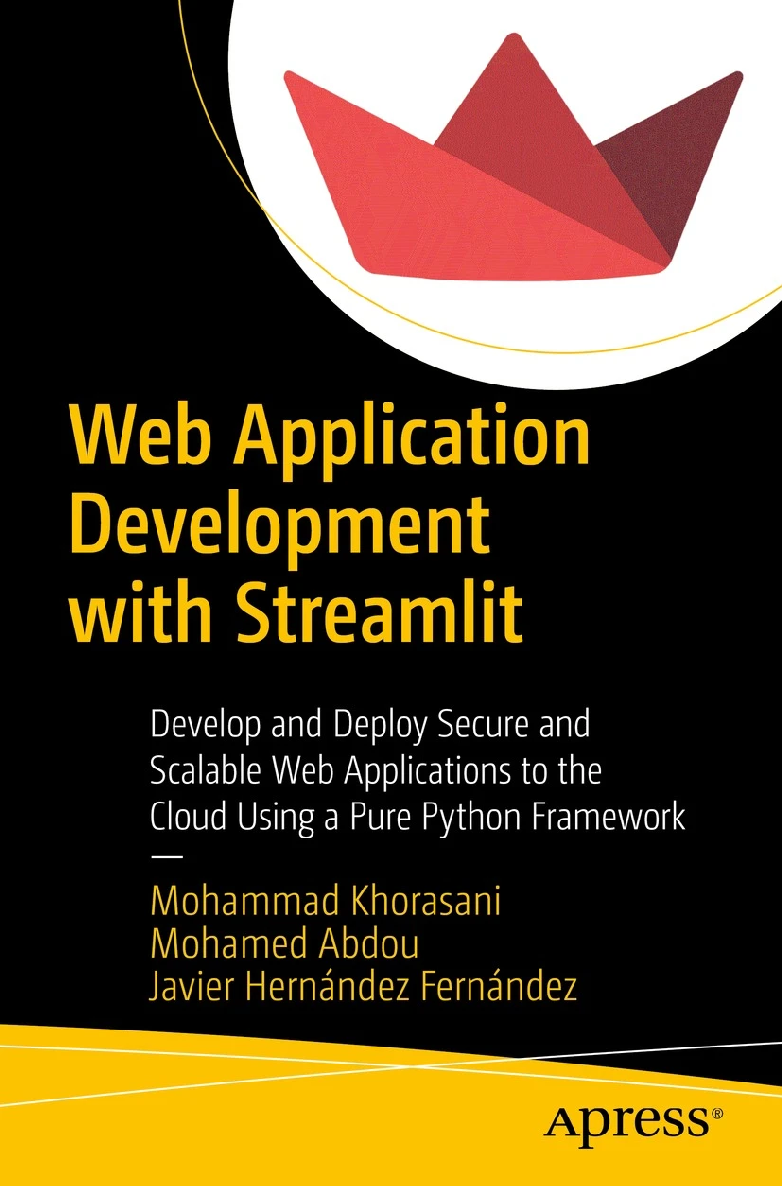 Web ApplicationDevelopment withStreamlitDevelop and Deploy Secureand Scalable Web Applicationsto the Cloud Using a PurePython FrameworkMohammad KhorasaniMohamed AbdouJavier Hernndez FernndezWeb Application Development with Streamlit: Develop and Deploy Secureand Scalable Web Applications to the Cloud Using a Pure Python Framework Mohammad Khorasani Mohamed Abdou Doha, Qatar Cambridge, United Kingdom Javier Hernndez Fernndez Doha, Qatar ISBN-13 (pbk): 978-1-4842-8110-9 ISBN-13 (electronic): 978-1-4842-8111-6 https://doi.org/10.1007/978-1-4842-8111-6 Copyright 2022 by Mohammad Khorasani, Mohamed Abdou, Javier Hernndez Fernndez This work is subject to copyright. All rights are reserved by the Publisher, whether the whole or part of the material is concerned, specifically the rights of translation, reprinting, reuse of illustrations, recitation, broadcasting, reproduction on microfilms or in any other physical way, and transmission or information storage and retrieval, electronic adaptation, computer software, or by similar or dissimilar methodology now known or hereafter developed. Trademarked names, logos, and images may appear in this book. Rather than use a trademark symbol with every occurrence of a trademarked name, logo, or image we use the names, logos, and images only in an editorial fashion and to the benefit of the trademark owner, with no intention of infringement of the trademark. The use in this publication of trade names, trademarks, service marks, and similar terms, even if they are not identified as such, is not to be taken as an expression of opinion as to whether or not they are subject to proprietary rights. While the advice and information in this book are believed to be true and accurate at the date of publication, neither the authors nor the editors nor the publisher can accept any legal responsibility for any errors or omissions that may be made.
Web ApplicationDevelopment withStreamlitDevelop and Deploy Secureand Scalable Web Applicationsto the Cloud Using a PurePython FrameworkMohammad KhorasaniMohamed AbdouJavier Hernndez FernndezWeb Application Development with Streamlit: Develop and Deploy Secureand Scalable Web Applications to the Cloud Using a Pure Python Framework Mohammad Khorasani Mohamed Abdou Doha, Qatar Cambridge, United Kingdom Javier Hernndez Fernndez Doha, Qatar ISBN-13 (pbk): 978-1-4842-8110-9 ISBN-13 (electronic): 978-1-4842-8111-6 https://doi.org/10.1007/978-1-4842-8111-6 Copyright 2022 by Mohammad Khorasani, Mohamed Abdou, Javier Hernndez Fernndez This work is subject to copyright. All rights are reserved by the Publisher, whether the whole or part of the material is concerned, specifically the rights of translation, reprinting, reuse of illustrations, recitation, broadcasting, reproduction on microfilms or in any other physical way, and transmission or information storage and retrieval, electronic adaptation, computer software, or by similar or dissimilar methodology now known or hereafter developed. Trademarked names, logos, and images may appear in this book. Rather than use a trademark symbol with every occurrence of a trademarked name, logo, or image we use the names, logos, and images only in an editorial fashion and to the benefit of the trademark owner, with no intention of infringement of the trademark. The use in this publication of trade names, trademarks, service marks, and similar terms, even if they are not identified as such, is not to be taken as an expression of opinion as to whether or not they are subject to proprietary rights. While the advice and information in this book are believed to be true and accurate at the date of publication, neither the authors nor the editors nor the publisher can accept any legal responsibility for any errors or omissions that may be made.
The publisher makes no warranty, express or implied, with respect to the material contained herein. Managing Director, Apress Media LLC: Welmoed Spahr Acquisitions Editor: James Robinson-Prior Development Editor: James Markham Coordinating Editor: Jessica Vakili Distributed to the book trade worldwide by Springer Science+Business Media New York, 233 Spring Street, 6th Floor, New York, NY 10013. Phone 1-800-SPRINGER, fax (201) 348-4505, e-mail orders-ny@springer-sbm.com, or visit www.springeronline.com. Apress Media, LLC is a California LLC and the sole member (owner) is Springer Science + Business Media Finance Inc (SSBM Finance Inc). SSBM Finance Inc is a Delaware corporation. For information on translations, please e-mail booktranslations@springernature.com; for reprint, paperback, or audio rights, please e-mail bookpermissions@springernature.com.
Apress titles may be purchased in bulk for academic, corporate, or promotional use. eBook versions and licenses are also available for most titles. For more information, reference our Print and eBook Bulk Sales web page at http://www.apress.com/bulk-sales. Any source code or other supplementary material referenced by the author in this book is available to readers on the Github repository: https://github.com/Apress/Web- Application-Development- with- Streamlit. For more detailed information, please visit http://www.apress.com/ source- code. the Cloud .................................................................................2 1.1.2 A Trend Toward Cloud Computing ...........................................................3 1.1.3 History of Web Frameworks in Python ...................................................5 1.1.4 Flask .......................................................................................................6 1.1.5 Django ....................................................................................................6 1.1.6 Dash .......................................................................................................7 1.1.7 Web2Py ...................................................................................................7 1.1.8 The Need for a Pure Python Web Framework .........................................8 1.1.9 Academic Significance ...........................................................................8 1.2 Firing It Up.......................................................................................................9 1.2.1 Technical Requirements .........................................................................9 1.2.2 Environment Installation with Anaconda ..............................................10 v Table of ConTenTs 1.2.3 Downloading and Installing Streamlit ...................................................15 1.2.4 Streamlit Console Commands ..............................................................17 1.2.5 Running Demo Apps .............................................................................19 1.2.6 Writing and Testing Code with PyCharm ...............................................21 1.3 How Streamlit Works.....................................................................................25 1.3.1 The Streamlit Architecture ....................................................................26 1.3.2 ReactJS in Streamlit .............................................................................29 1.4 Summary.......................................................................................................30 Chapter 2: Streamlit Basics 31 2.1 Creating a Basic Application .........................................................................31 2.1.1 Generating User Input Forms ................................................................32 2.1.2 Introducing Conditional Flow ................................................................34 2.1.3 Managing and Debugging Errors ..........................................................36 2.2 Mutating Dataframes ....................................................................................40 2.2.1 Filter .....................................................................................................41 2.2.2 Select ...................................................................................................42 2.2.3 Arrange .................................................................................................44 2.2.4 Mutate ..................................................................................................46 2.2.5 Group By ...............................................................................................48 2.2.6 Merge ...................................................................................................49 2.3 Rendering Static and Interactive Charts .......................................................52 2.3.1 Static Bar Chart ....................................................................................52 2.3.2 Static Line Chart ...................................................................................53 2.3.3 Interactive Line Chart ...........................................................................55 2.3.4 Interactive Map .....................................................................................57 2.4 Developing the User Interface .......................................................................58 2.5 Summary.......................................................................................................62 vi Table of ConTenTs Chapter 3: Architecting the User Interface 63 3.1 Designing the Application .............................................................................64 3.1.1 Configuring the Page ............................................................................64 3.1.2 Developing Themes and Color schemes ...............................................77 3.1.3 Organizing the Page .............................................................................81 3.2 Displaying Dynamic Content .........................................................................85 3.2.1 Creating a Real-Time Progress Bar ......................................................87 3.3 Provisioning Multipage Applications .............................................................88 3.3.1 Creating Pages .....................................................................................88 3.3.2 Creating Subpages ...............................................................................91 3.4 Modularizing Application Development .........................................................94 3.4.1 Example: Developing a Social Network Application .............................95 3.4.2 Best Practices for Folder Structuring .................................................101 3.5 Summary.....................................................................................................104 Chapter 4: Data Management and Visualization 105 4.1 Data Management .......................................................................................106 4.1.1 Processing Bytes Data ........................................................................106 4.1.2 Caching Big Data ................................................................................108 4.1.3 Mutating Data in Real Time ................................................................111 4.1.4 Advanced and Interactive Data Mutation ............................................113 4.2 Exploring Plotly Data Visualizations ............................................................120 4.2.1 Rendering Plotly in Streamlit ..............................................................120 4.2.2 Basic Charts .......................................................................................121 4.2.3 Statistical Charts ................................................................................125 4.2.4 Time-Series Charts .............................................................................127 4.2.5 Geospatial Charts ...............................................................................128 4.2.6 Animated Visualizations ......................................................................128 4.3 Summary.....................................................................................................131 vii Table of ConTenTs Chapter 5: Database Integration 133 5.1 Relational Databases ..................................................................................133 5.1.1 Introduction to SQL .............................................................................134 5.1.2 Connecting a PostgreSQL Database to Streamlit ...............................136 5.1.3 Displaying Tables in Streamlit ............................................................141 5.2 Nonrelational Databases .............................................................................144 5.2.1 Introduction to MongoDB ....................................................................145 5.2.2 Provisioning a Cloud Database ...........................................................146 5.2.3 Full-Text Indexing ...............................................................................150 5.2.4 Querying the Database .......................................................................152 5.2.5 Displaying Tables in Streamlit ............................................................157 5.3 Summary.....................................................................................................160 Chapter 6: Leveraging Backend Servers 161 6.1 The Need for Backend Servers ...................................................................161 6.2 Frontend-Backend Communication ............................................................162 6.2.1 HTTP Methods ....................................................................................163 6.3 Working with JSON Files .............................................................................164 6.4 Provisioning a Backend Server ...................................................................165 6.4.1 API Building ........................................................................................166 6.4.2 API Testing ..........................................................................................170 6.5 Multithreading and Multiprocessing Requests ...........................................171 6.6 Connecting Streamlit to a Backend Server .................................................174 6.7 Summary.....................................................................................................177 viii Table of ConTenTs Chapter 7: Implementing Session State 179 7.1 Implementing Session State Natively .........................................................179 7.1.1 Building an Application with Session State ........................................182 7.2 Introducing Session IDs ..............................................................................185 7.3 Implementing Session State Persistently ...................................................186 7.4 User Insights ...............................................................................................191 7.4.1 Visualizing User Insights .....................................................................195 7.5 Cookie Management ...................................................................................198 7.6 Summary.....................................................................................................202 Chapter 8: Authentication and Application Security 203 8.1 Developing User Accounts ..........................................................................203 8.1.1 Hashing ..............................................................................................204 8.1.2 Salting ................................................................................................205 8.2 Verifying User Credentials ...........................................................................207 8.3 Secrets Management ..................................................................................224 8.4 Anti-SQL Injection Measures with SQLAlchemy ..........................................225 8.5 Configuring Gitignore Variables ...................................................................226 8.6 Summary.....................................................................................................227 Chapter 9: Deploying Locally and to the Cloud 229 9.1 Exposing Streamlit to the World Wide Web .................................................230 9.1.1 Port Forwarding over a Network Gateway ..........................................230 9.1.2 HTTP Tunneling Using NGROK .............................................................232 9.2 Deployment to Streamlit Cloud ...................................................................235 9.2.1 One-Click Deployment ........................................................................235 9.2.2 Streamlit Secrets ................................................................................238 ix Table of ConTenTs 9.3 Deployment to Linux ...................................................................................240 9.3.1 Native Deployment on a Linux Machine .............................................240 9.3.2 Deployment with Linux Docker Containers .........................................243 9.4 Deployment to Windows Server ..................................................................246 9.4.1 Establishing a Remote Desktop Connection .......................................247 9.4.2 Opening TCP/IP Ports ..........................................................................249 9.4.3 Anaconda Offline Package Installation ...............................................253 9.4.4 Adding Anaconda to System Path .......................................................254 9.4.5 Running Application as an Executable Batch File ...............................256 9.4.6 Running Application As a Persistent Windows Service ......................257 9.5 Summary.....................................................................................................261 Chapter 10: Building Streamlit Components 263 10.1 Introduction to Streamlit Custom Components .........................................263 10.2 Using ReactJS to Create Streamlit Custom Components ..........................264 10.2.1 Making a ReactJS Component .........................................................265 10.2.2 Using a ReactJS Component in Streamlit .........................................268 10.2.3 Sending Data to the Custom Component ..........................................270 10.2.4 Receiving Data from the Custom Component ...................................273 10.3 Publishing Components As Pip Packages .................................................276 10.4 Component in Focus: Extra-Streamlit- Components ..................................280 10.4.1 Stepper Bar ......................................................................................280 10.4.2 Bouncing Image ................................................................................286 10.4.3 Tab Bar ..............................................................................................290 10.4.4 Cookie Manager................................................................................295 10.4.5 Router ...............................................................................................302 10.5 Summary...................................................................................................307 x Table of ConTenTs Chapter 11: Streamlit Use Cases 309 11.1 Dashboards and Real-Time Applications ..................................................309 11.1.1 Temperature Data Recorder Application ...........................................310 11.1.2 Motor Command and Control Application .........................................316 11.2 Time-Series Applications ..........................................................................321 11.2.1 Date-Time Filter Application .............................................................321 11.2.2 Time-Series Heatmap Application ....................................................324 11.2.3 Time Synchronization Application .....................................................328 11.3 Data Management and Machine Learning Applications ............................332 11.3.1 Data Warehouse Application .............................................................332 11.3.2 Advanced Application Development: Machine Learning As a Service ..............................................................................................344 11.4 Summary...................................................................................................361 Chapter 12: Streamlit at Work 363 12.1 Streamlit in Clean Energy:
Next pageFont size:
Interval:
Bookmark:
Similar books «Web Application Development with Streamlit: Develop and Deploy Secure and Scalable Web Applications to the Cloud Using a Pure Python Framework»
Look at similar books to Web Application Development with Streamlit: Develop and Deploy Secure and Scalable Web Applications to the Cloud Using a Pure Python Framework. We have selected literature similar in name and meaning in the hope of providing readers with more options to find new, interesting, not yet read works.
Discussion, reviews of the book Web Application Development with Streamlit: Develop and Deploy Secure and Scalable Web Applications to the Cloud Using a Pure Python Framework and just readers' own opinions. Leave your comments, write what you think about the work, its meaning or the main characters. Specify what exactly you liked and what you didn't like, and why you think so.

